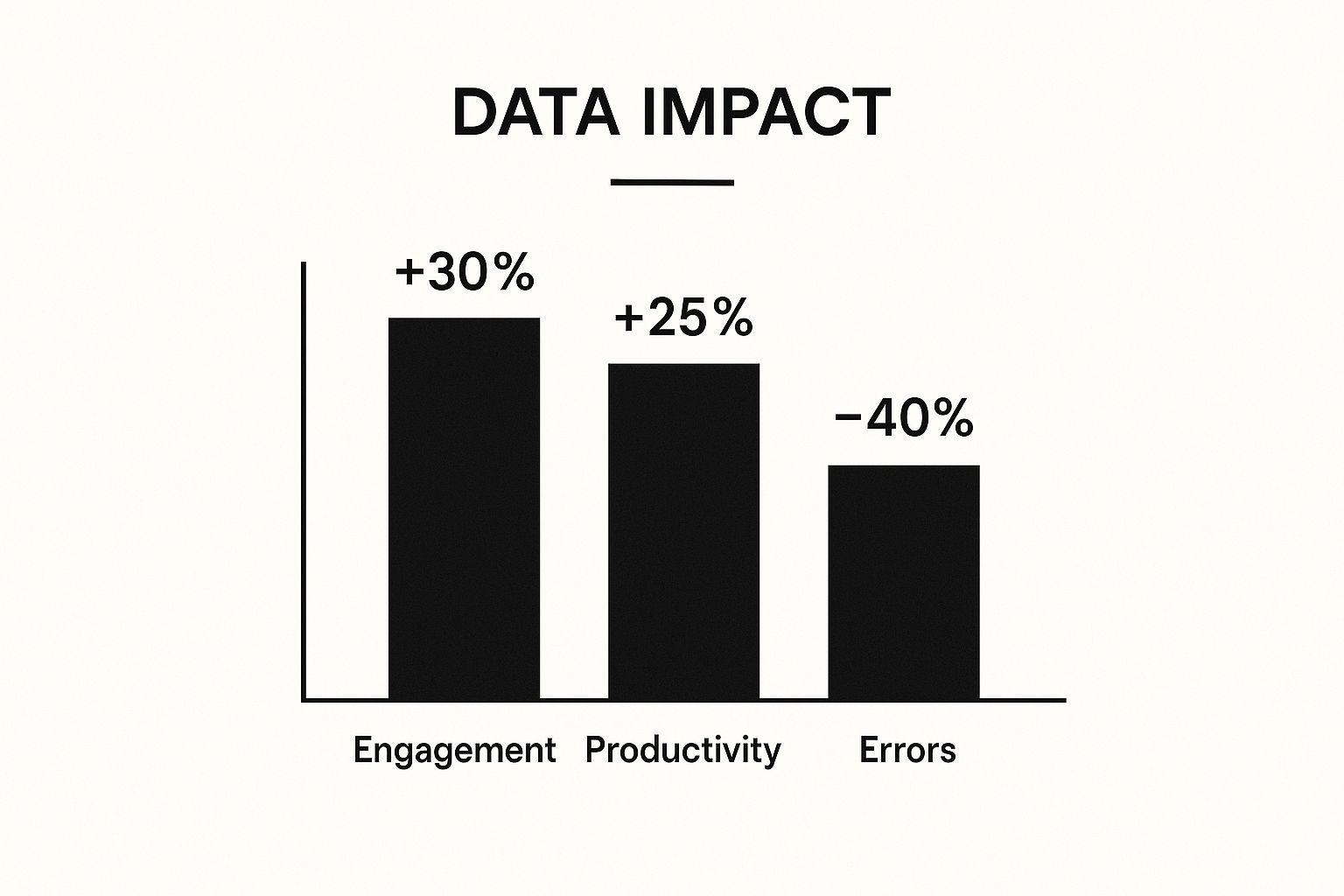The True Price of Disconnection: Why Your Team's Communication Challenges Cost More Than You Realize

We've all seen it happen: messages vanish into thin air, instructions get jumbled, and well-intentioned projects somehow veer off course. This isn't merely a daily irritation; when your team struggles to connect, it quietly siphons away precious resources. Many leaders recognize these communication breakdowns not as isolated mishaps, but as signals of deeper challenges, showing that typical quick solutions often don't get to the heart of the matter.
The Hidden Currents of Misunderstanding
Telling your team to simply "communicate better" is like putting a bandage on a deeper wound – it rarely addresses the true source of the problem. The brilliant George Bernard Shaw once said, "The single biggest problem in communication is the illusion that it has taken place." This powerful illusion takes root when the actual causes of miscommunication, like fuzzy expectations or a shortage of genuine listening, go unnoticed. For instance, leaders who assume communication just happens can misjudge the dedication needed for true clarity, particularly in our intricate work settings.
These subtle yet persistent patterns are often the culprits behind major setbacks. Imagine a team member caught between conflicting directions from two different managers about an essential client report. The result? Confusion, delays, and the draining task of redoing work, all of which consume valuable time and energy. These situations clearly show how internal communication snags can affect project deadlines and client happiness, bringing to light the crucial need for focused communication training for employees.
The Rising Price of Being Out of Sync
The monetary impact of weak communication reaches much further than most businesses comprehend. These costs show up in several ways:
- Vanishing Deadlines: When directions are muddled or information isn't passed along smoothly, deadlines naturally suffer.
- Dwindling Productivity: Team members can lose so much time trying to get clarity or fixing mistakes that sprout from miscommunication. A notable report found that 30% of employees felt exasperated by unclear messages from their managers.
- Sinking Morale and Connection: Ongoing communication struggles can breed frustration, detachment, and can even lead to more people leaving the team.
- Lost Client Relationships: It's easy for misunderstandings to affect client interactions, potentially harming relationships and leading to lost opportunities.
These hurdles can feel even bigger in hybrid and remote teams. With less in-person contact, the subtle parts of communication can get lost, making remote colleagues feel disconnected or uninformed. This environment makes well-designed communication training for employees an absolute must. The effect is significant: a striking 86% of employees and executives point to poor collaboration and communication as the primary reasons for failures at work. This isn't just a temporary problem; identified in 2023 and expected to continue into 2025, subpar communication is thought to cost businesses worldwide an incredible $1.2 trillion each year. Discover more in-depth figures on communication impacts.
Transforming Costs into Opportunities for Growth
Recognizing these substantial costs changes how we view communication training for employees. It’s far more than just polishing a 'soft skill' or ticking off an HR requirement. Forward-thinking organizations see it as a vital investment that delivers real, measurable benefits. By tackling the core reasons for miscommunication and giving teams powerful strategies, companies can reduce these unseen drains and cultivate a workplace that’s more productive, united, and effective. Taking this step forward is key to successfully moving through today's business world and creating a strong, adaptable company spirit.
Designing Training Programs That People Actually Want To Attend
To build a truly vibrant and flexible team spirit, we need to think differently about learning. It's about crafting experiences that genuinely connect with your people. Let go of the tired old slideshows and awkward role-plays; modern communication training for employees should feel fresh, engaging, and deliver outcomes that matter. The real magic happens when programs are not just interesting but also directly useful in your team's day-to-day work.
This adventure into better training starts by truly getting to know your team's communication habits and needs. Leading companies take the time to look at how their teams currently talk to each other, maybe using confidential feedback or small group chats, to find specific areas for growth. This first step is so important because it helps create focused learning journeys that respect everyone's unique style and how they learn best, instead of a generic approach. For instance, one group might need help writing clearer emails, while another wants to boost their confidence for client presentations.
Crafting Engaging and Relevant Learning Modules
Once you have a good sense of what’s needed, the fun part begins: using creative training ideas that grab attention and help skills really take root. Think about these possibilities:
- Peer Coaching: People often absorb information best from colleagues they trust. Setting up chances for team members to give and get feedback from each other can make learning stick in a friendly way.
- Real-World Scenario Simulations: Move beyond theory. Let employees dive into simulations that feel like real job situations. This gives them a safe place to try out new communication approaches before using them when the stakes are high.
- Microlearning Modules: We all know time is valuable. Microlearning offers small, easy-to-handle pieces of information on big topics. These can be accessed whenever needed, fitting into busy days and helping to lock in key ideas without feeling like too much.
The need for excellent communication abilities is stronger than ever. Recent findings show that 57% of employers worldwide see communication as the top skill they look for. Furthermore, 55% of recruiters put a high value on verbal communication skills, with presentation skills at 47% and active listening at 36%. These numbers really show how essential these skills are. Discover more about the demand for communication skills from Pumble's research. This information underlines why dedicated communication training for employees that sharpens these specific abilities is so incredibly important.
Prioritizing Key Communication Competencies
A truly effective training plan will thoughtfully combine timeless person-to-person skills with essential digital communication know-how. Being a great listener and speaking clearly are always vital, but being skilled in online interactions is just as critical for today's connected teams.
To help you identify what to focus on, here's a look at some key communication skills, how employers value them, and their importance in training programs.
Essential Communication Skills Training Components
A breakdown of core communication skills valued by employers and their training priority levels.
| Communication Skill | Employer Value (%) | Training Priority | Training Method |
|---|---|---|---|
| Active Listening | High (Implied by 36%) | High | Interactive workshops, Role-playing, Feedback sessions |
| Verbal Communication | 55% | High | Impromptu speaking exercises, Scenario practice |
| Written Communication | High | High | Email etiquette guides, Clarity workshops, Peer review |
| Presentation Skills | 47% | High | Practice sessions, Video feedback, Storytelling |
| Non-Verbal Cues | Medium | Medium | Observational exercises, Body language awareness |
| Digital Etiquette | High | High | Best practice guides, Video call simulations |
| Conflict Resolution | Medium | Medium | Case studies, Negotiation simulations |
This table highlights the blend of skills modern professionals need. Focusing training on highly valued skills like verbal communication and active listening, while also addressing digital etiquette, can prepare your team for diverse challenges.
The positive changes from thoughtfully created communication training can be remarkable. The image below shows some of the real advantages seen when training successfully meets skill needs and truly involves everyone:

It's clear that well-aimed training can bring about big boosts in team spirit (+30% Engagement) and efficiency (+25% Productivity), and also cut down on expensive mistakes (-40% Errors) caused by poor communication. This makes putting resources into quality communication training for employees a smart move for any forward-thinking organization.
Measuring Success and Iterating for Lasting Impact
Finally, creating a program that people are excited about also involves showing its worth and being open to making it even better. Set up simple ways to see how engaged people are, like seeing how many complete the microlearning bits or by asking for honest thoughts after training. Even more importantly, watch for changes in how people work and ask what parts of the training are helping the most. This ongoing conversation helps you make quick adjustments, making sure your communication training for employees stays fresh, effective, and truly supports the growing needs of your team and your entire organization.
Proving Your Training Investment Actually Pays Off

Ever wondered if your investment in communication training for employees truly makes a difference? It might feel like a tricky question, but uncovering the real impact is often more straightforward than many organizations imagine. The secret is in pinpointing and consistently watching the right progress markers from the very beginning. This careful method helps you clearly show the real-world advantages that better communication brings to your whole team.
Before any new training journey begins, it’s absolutely vital to set your baseline measurements. Think of it as capturing a "before" picture of how your team communicates. Without this initial understanding, trying to measure real growth is like navigating without a map, making it tough to show the true worth of your efforts. This early data gives you a solid rock to build upon, against which all future successes can be joyfully compared.
Key Metrics for Measuring Training Success
With your starting point clear, you can now watch the magic unfold through specific Key Performance Indicators (KPIs). These are the markers that directly mirror the positive changes brought about by your communication training for employees, giving you solid proof of its success. For instance, productivity metrics often take center stage. It’s not about pushing people to work harder, but enabling them to work smarter; good communication smooths out daily tasks and cuts down on wasted effort. In fact, studies show that teams communicating effectively can see their productivity jump by up to 25%. This truly shows the powerful benefit of investing in communication skills, tackling slowdowns and paving the way for big wins in performance. Explore this topic further for more insights on communication's impact on productivity.
What's more, other important KPIs to keep an eye on include:
- Collaboration Scores: Seen through team surveys or information from project management tools, these show how teamwork is flourishing.
- Customer Satisfaction Improvements: Witnessed in positive feedback, glowing reviews, and a welcome drop in complaints.
- Reduced Project Timelines: A clear sign of more effective ways of working and fewer hold-ups caused by unclear messages.
- Improved Employee Retention Rates: Because when communication shines, people often feel happier and more connected to their work.
Demonstrating Value: Real-World Returns
Beyond these important indicators, the financial uplift from effective communication training for employees can be seen in direct cost savings. Imagine the decrease in mistakes that once led to do-overs or squandered resources. When messages are clear, miscommunication incidents decrease significantly, which saves both precious time and valuable money.
Furthermore, better communication often leads to faster decision-making processes, as information travels more freely and accurately. Teams find themselves spending less time asking for clarity and more time taking confident action. Another wonderful saving comes from reduced conflict resolution time. When your people have better communication tools, they can work through disagreements in a more positive way, keeping disruptions small and freeing up managers' time. Organizations that keep track of these areas often discover powerful proof of their training’s positive financial ripple effect.
When you share these remarkable results with leadership, aim for a story that is both clear and backed by facts. Use visuals like charts and graphs to beautifully show the progress made. By directly linking better communication to concrete benefits like cost savings, higher productivity, and better staff loyalty, you build an undeniable case for continued support and resources for future communication training for employees. This ensures that open and effective communication becomes a cherished and constantly nurtured skill within your organization.
Getting Past The Roadblocks That Kill Training Programs
Even when your organization sees the incredible value of communication training for employees and is ready to help these skills flourish, the journey to success can present some common hurdles. But don't lose heart! These challenges are completely manageable with a bit of foresight and smart planning. This way, your training efforts will hit the mark, nurturing a workplace where clear, impactful interactions become the norm.
Tackling Time Scarcity Head-On
One of the biggest mountains to climb is often the feeling of not having enough time. We know professionals are busy, balancing many tasks, which can make finding dedicated hours for training seem tough. In fact, 48% of professionals say lack of time is the main reason they can't fully engage with training, and 16.7% also highlight a shortage of needed skills within their teams. These are exactly the areas that strong communication training for employees is designed to strengthen. Discover more insights into employee training challenges from murf.ai.
To gracefully move past this, think about using microlearning approaches. This means breaking down training into small, powerful bursts—perhaps 5-15 minute lessons—that your team can access whenever it suits them. Also, weaving learning directly into the daily flow, like sharing quick tips or fun, scenario-based challenges tied to everyday work, transforms skill growth into an ongoing journey, not just a one-off event.
Securing Managerial Support and Ensuring Accountability
Having managers on board is absolutely vital. Securing manager buy-in means they become champions of the training, encouraging their teams to use and practice new communication skills. Without their active support and belief in its value, the training's impact can fade, and new habits won't stick.
Here’s how you can build that powerful partnership:
- Invite managers into the creation process for the communication training for employees. This ensures it truly speaks to their team's unique needs and day-to-day situations.
- Show them clearly how better communication will directly uplift their team’s results, smooth out conflicts, and boost the productivity measures they focus on.
Alongside enthusiastic managers, you need clear accountability systems. Learning is a continuous adventure, not a destination. Encourage ongoing practice by creating peer coaching duos, weaving communication goals into performance chats, or using team huddles as safe spaces to try out new techniques together.
Addressing Diverse Skill Sets and Maintaining Engagement
Every team is a wonderful mix of individuals, and that means a spectrum of communication strengths. Some might be natural conversationalists, while others are working on areas like active listening or giving helpful feedback. For communication training for employees to truly make a difference, it must embrace these varying skill levels.
You can achieve this by:
- Using initial assessments to gently understand current abilities and pinpoint specific areas ripe for growth.
- Offering differentiated learning paths or optional modules, allowing individuals to focus on the skills most meaningful to them.
- Cultivating a warm, supportive learning atmosphere where everyone feels safe to practice, make mistakes, and learn from one another’s journeys.
Keeping the energy and focus alive, especially when work is buzzing, also needs a thoughtful touch. Regularly revisit key ideas from the communication training for employees, cheer for small victories, and share success stories that bloom from improved communication. This keeps the training fresh and underscores its lasting importance. Think about appointing communication champions within teams—they can be the friendly faces who keep the momentum going, answer questions, and offer peer encouragement.
Finally, it’s so important to shape programs that honor diverse communication styles and cultural backgrounds. What feels like clear or respectful communication can differ across cultures and personal preferences. Your training materials and how you present them should be inclusive, recognizing these beautiful differences and fostering understanding and flexibility in every interaction. This ensures your communication training for employees connects with everyone, building genuine skill and leading to a more united and empathetic workforce.
Mastering Digital Communication In An AI-Powered Workplace

It's remarkable how quickly the old ways of communicating at work just don't cut it anymore. The ground is shifting beneath our feet, and fast! This rapid change means that many established communication training for employees programs are finding it hard to stay relevant. Artificial intelligence (AI) is a big part of this shift, not just changing what we do, but fundamentally altering how we connect and work together.
The Evolving Skillset: What Your Team Needs Now
To truly flourish as our workplaces change, your team needs to cultivate a fresh set of digital communication abilities. It’s about more than just learning new software; it's about skillfully applying timeless communication wisdom to our digital interactions. Take video conferencing mastery, for instance. It's no longer enough to just show up online; it demands a compelling virtual presence, speaking clearly, and truly connecting with people who aren't physically there. Likewise, compelling digital presentation techniques now call for sharp, visually engaging content and interactive features to keep everyone hooked.
Being effective at written communication across multiple platforms simultaneously—whether it's through instant messages, project updates, emails, or internal company forums—is all about being clear, concise, and knowing your audience. It's fascinating to see that 89% of leaders and 52% of knowledge workers are already using generative AI tools, showing just how essential these digital skills have become. What's truly uplifting is that 73% of knowledge workers find these AI tools actually help them sidestep misunderstandings, proving AI can be a wonderful ally in our communication. You can explore this topic further and see more communication statistics to see the bigger picture. This tells us that impactful communication training for employees must embrace these AI-assisted methods.
Bridging The Digital Divide: Tech Proficiency And Emotional Intelligence
While getting comfortable with new technologies is absolutely key, let's not forget the incredible power of emotional intelligence (EQ). The most successful teams know that digital tools are there to deepen, not substitute, genuine human bonds. That’s why training should champion abilities like showing empathy online, truly listening in virtual meetings, and understanding the nuances (or lack thereof) in digital messages.
Finding this sweet spot means technology becomes a way to connect us, not drive us apart. Think about it: an email polished by an AI assistant still needs that human warmth to strike the right note and build real connection. So, communication training for employees should inspire everyone to see technology as a partner that elevates our human interactions, nurturing understanding and building even stronger team bonds.
Adapting Training For Modern Work Realities
Today's work environments, with their mix of in-office and remote work and teams spread across different places, bring new communication puzzles to solve. Truly effective communication training for employees meets these new situations with enthusiasm and practical solutions.
Let's look at some vital areas where your team can grow:
- Asynchronous Communication: Imagine teams confidently sharing clear, to-the-point updates and notes that don’t need an instant reply. This respects everyone's time and different schedules, making collaboration smoother.
- Cross-Cultural Digital Interactions: Equip your people with the insight to navigate how different cultural backgrounds can shape online conversations. This helps avoid confusion and builds a truly welcoming environment for all.
- Maintaining Team Cohesion: Especially when some are in the office and some are remote, consciously building team spirit is essential. Training can spark ideas for fun virtual get-togethers or share ways to make every hybrid meeting feel inclusive and connected.
The way we approach communication training has certainly transformed. The following table offers a glimpse into how the core elements of this training have shifted to meet the demands of today's digitally-driven workplaces compared to more conventional settings.
Traditional vs. Digital Communication Training Focus Areas
Comparison of communication training components needed for traditional workplace versus modern digital-first environments.
| Communication Type | Traditional Focus | Digital Focus | Integration Strategy |
|---|---|---|---|
| Meetings | In-person, formal agendas, physical presence cues | Video conferencing, virtual engagement, chat etiquette, screen sharing | Hybrid meeting protocols, training on virtual facilitation, tools for engagement |
| Written Correspondence | Formal memos, letters, long-form reports | Email, instant messaging, collaborative documents, concise updates | Platform-specific writing guidelines, AI-assisted writing tools, digital tone awareness |
| Feedback | Face-to-face reviews, annual performance discussions | Real-time digital feedback, asynchronous comments, performance dashboards | Training on giving/receiving digital feedback, using tools constructively |
| Team Collaboration | Physical co-location, whiteboard sessions | Shared digital workspaces, cloud-based tools, asynchronous project updates | Workshops on digital collaboration tools, fostering virtual team cohesion |
This comparison clearly shows a move towards more immediate, flexible, and tool-supported communication methods. The goal is always to connect effectively, no matter the medium.
And the journey doesn't stop here! New ways to communicate are always appearing, changing how we connect with each other. That’s why embracing continuous learning is so important. By nurturing adaptability and a keen interest in exploring new tools and methods, you can empower your team to not just keep up, but to lead the way in this ever-exciting world of communication.
Building Communication Excellence That Lasts
The real triumph of communication training for employees isn't just in those initial moments of understanding; it’s in seeing those skills become a living, breathing part of your organization, growing stronger each day. Imagine a workplace where clear, impactful communication isn't a special effort, but just the way things get done. This dedication to long-term growth is what truly makes your investment flourish.
Embedding Skills into Daily Workflows
For communication improvements to truly take root, they need to blend seamlessly into your company’s culture, not feel like an extra task. This means weaving new practices into the everyday rhythm of work. For instance, after a session on writing clearer emails, teams might adopt a simple checklist for important messages. This is how abstract training concepts bloom into practical, everyday habits.
This shift needs consistent encouragement. When new communication approaches are actively supported and modeled by leaders and colleagues, they're far more likely to spread. The aim is for effective communication to become so natural it’s like breathing – an inherent skill in every employee’s repertoire.
The Power of Peer Support and Continuous Feedback
A wonderfully effective way to solidify learning from communication training for employees is through peer mentoring systems. When colleagues support each other in applying new skills, it creates a comfortable space for practice and open discussion. Mentors can offer real-world insights and help peers tackle communication hurdles as they appear, transforming daily interactions into valuable learning moments. This ongoing dialogue cements understanding far more deeply than initial training alone.
Furthermore, establishing strong feedback loops is vital for continuous skill development. This isn’t about formal critiques, but about fostering channels for regular, supportive conversations on communication effectiveness. When employees receive timely, specific feedback—and are encouraged to offer it too—they can pinpoint areas for growth and refine their methods. It's known that without follow-up, solicited feedback can lead to disinterest; thus, consistent feedback channels are essential.
Aligning Communication Goals with Career Growth
To truly highlight the significance of these abilities, organizations can benefit from incorporating communication assessment into performance reviews. When proficiency in communication is recognized as a key measure of performance, it clearly signals that these skills are prized and crucial for advancement within the company. This can inspire employees to actively use and cultivate what they’ve learned.
These assessments should then naturally flow into career development conversations. Discussing how strong communication skills can unlock new opportunities or leadership roles powerfully reinforces their strategic value. Directly linking effective communication to pathways for advancement makes continuous improvement a personal and professional aspiration for everyone.
Sustaining Momentum and Adapting to Change
To keep the spirit of communication excellence vibrant long after formal training ends, think about nurturing a network of internal communication champions. These enthusiastic individuals can serve as ongoing guides, keep the training momentum alive, and support their colleagues. They might organize informal learning meetups or share best practices, similar to how "Security Champions" bolster security awareness in organizations.
Finally, because our ways of working and communicating are always transforming, it’s crucial to have frameworks for refreshing training content. What defines effective communication can change with new tools, evolving team dynamics, or different business landscapes. Regularly reviewing and updating your communication training for employees ensures that skills stay sharp and applicable, equipping your team to adapt and flourish. This unwavering dedication to growth is the secret to building communication excellence that truly endures.
Key Takeaways
Having explored the 'why' and 'how' of creating meaningful workplace interactions, this is your path forward for impactful communication training for employees. We're here to help break down ambitious goals into clear, manageable actions. The focus is on practical steps, clear signs of success, and wise investment to ensure your training efforts spark enduring positive change.
Charting Your Course: Timelines and Budgeting for Communication Training
Think of bringing effective communication training for employees to life as an inspiring adventure, not a quick fix. It often starts with 1-2 months for a deep dive into your team's unique needs and aspirations, crafting a program that truly resonates. This is usually followed by a 2-4 month pilot phase with a select group to fine-tune the experience before a wider rollout. Full implementation across an organization can then take 6-12 months, supported by continuous encouragement to help these new skills become a natural part of your team's DNA.
When you think about the financial side, view communication training for employees as a powerful investment in your incredible team. While budgets differ, organizations might dedicate between $500 to $2,000 per employee for well-rounded programs, or set aside a specific portion of the overall Learning & Development budget. This commitment funds the creation, expert guidance or digital platform access, materials, and thorough evaluation, often bringing inspiring results like greater team flow and fewer setbacks.
Defining Victory: Key Success Indicators for Your Program
The success of your communication training for employees should be celebrated through different perspectives. Keep an eye on leading indicators such as participant engagement levels (aiming for over 75% active participation in workshops) and knowledge acquisition scores right after training sessions. These early signs are wonderful signs of the deeper, lasting impact to come, like visible growth in how teams work together or a happier customer base, typically noticeable 3-6 months post-training.
Beyond the numbers, capture the human impact. Collect anecdotal evidence and testimonials that shine a light on specific moments where the training has led to better outcomes. For instance, a team leader sharing a story about how improved listening skills helped ease a tense situation provides a testament to the real-world magic your program creates.
Choosing Your Partners and Crafting Program Essentials
Selecting the right external partner for your communication training for employees can greatly shape its success. Seek out partners who:
- Show a deep appreciation for adult learning principles and interactive methods.
- Offer meaningful customization to align the training with your distinct company culture, industry specifics, and particular communication challenges.
- Provide unwavering post-training support, including tools and resources to sustain learning.
- Maintain clear and open financial discussions and clearly describe deliverables and expected positive changes.
A thoughtfully crafted program is your cornerstone. Consider this checklist for developing your training:
- Targeted Needs Analysis: Start by identifying the key communication skills that will lift your teams.
- Vision of Change: Clearly picture the new abilities and actions your team members will gain after completing the training.
- Dynamic Learning: Mix inspiring workshops, self-paced online modules, personal guidance, and active practice.
- Real-World Application: Ensure content is full of job-relevant scenarios, case studies, and problem-solving activities.
- Embedded Evaluation Strategy: Plan from the start how you will measure both immediate learning and long-term behavioral shifts.
Expanding Your Reach: Scaling and Sustaining Effective Communication
To effectively spread communication training for employees across larger organizations or various departments, a vibrant mix of approaches often creates the best results. Digital learning platforms can share core wisdom widely and smoothly to many people. Simultaneously, in-person or live virtual workshops offer golden opportunities to practice skills, explore ideas deeply, and receive individual encouragement. Introducing a "communication champions" network—comprising trained employees who inspire and support their peers—can also be very effective in spreading both knowledge and excitement.
Ultimately, the aim is to nurture enduring shifts in how people connect. Keep the positive energy from communication training for employees flowing by weaving these competencies into job descriptions, the onboarding process for new hires, and performance management systems. Encourage managers to grow into communication coaches for their teams, fostering an environment of regular feedback and continuous practice. This approach turns training from a one-time moment into a continuous journey of growth, becoming a beautiful thread in the fabric of your organization.
Are you ready to empower your HR professionals to become catalysts for communication brilliance? We invite you to explore the enriching certification programs at the Global Human Resource Institute. Our courses are crafted to cultivate expert skills and connect a vibrant community of HR leaders shaping the future. Discover our HR Certification Programs and enhance your team's capabilities.




0 Comments